Important Message
This Website Terms and Condition of Use Agreement
also known as a 'terms of service agreement'
Will be at the bottom of most web pages!
Please read it before using this website.
Thank You
|
|
"To live in the hearts we leave behind, is never to have died."
|
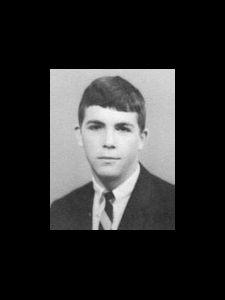 |
| Floyd Andrew Deal |
|
|
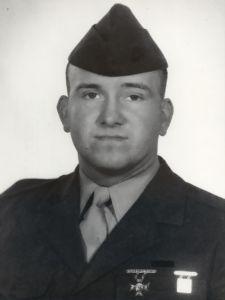 |
| Karl Gorman Taylor |
|
|
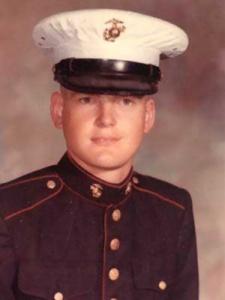 |
| Patrick M. R. Bierlein |
|
|
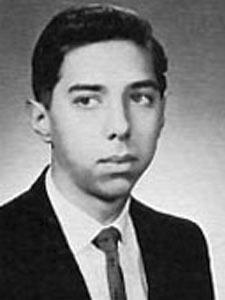 |
| Richard Philip Yanchuk, Jr |
|
|
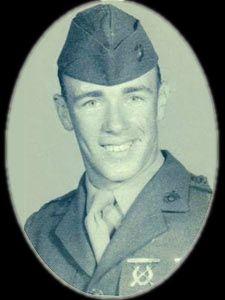 |
| William Michael Coomes |
|
|
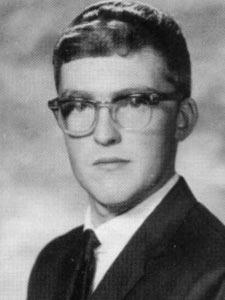 |
| Melvin Lynn Applebury |
|
|
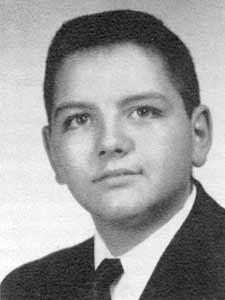 |
| DeWitt Stanley Vance |
|
|
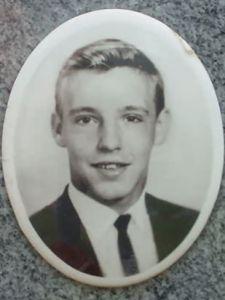 |
| Raymond Farley Trantham |
|
|
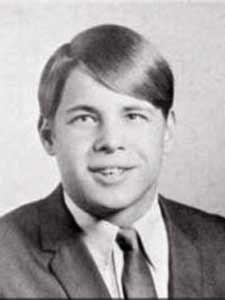 |
| Richard Michael Schwab |
|
|
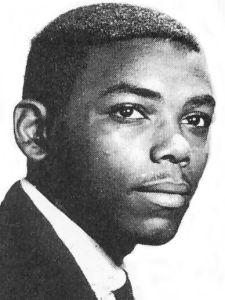 |
| John Wesley Terrell |
|
|
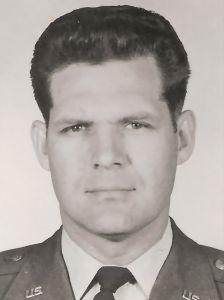 |
| Aquilla Friend Britt |
|
|
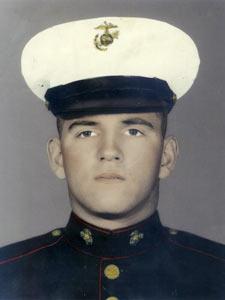 |
| James Sefrhans |
|
|
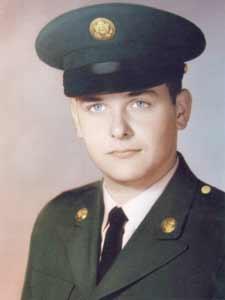 |
| Richard Anthony Choppa |
|
|
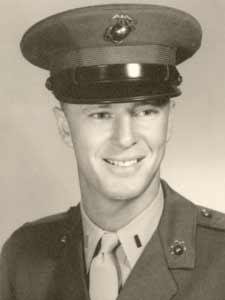 |
| Franklin Delano Bynum |
|
|
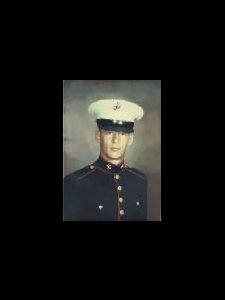 |
| Richard Herman Johnson |
|
|
 |
| Frederick Vernon Seaborne |
|
|
 |
| John Winters |
|
|
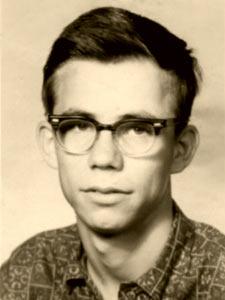 |
| Dale Lee Lambert |
|
|
|
|
 |
| John Michael Tanney |
|
|
|
No Man Left Behind part 4
|
|
On Behalf of a Grateful Nation
|
This page is in remembrance of the men and women who gave there all for our feedom, and to the ones still missing in Vietnam, And the vets still alive, thank you and my prayers go out to them.God Bless You All
|
|
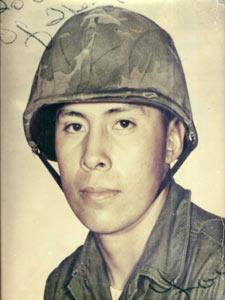 |
| Thomas Lee LittleSun |
|
| |
Thomas Lee LittleSun was a full blood (4/4) Pawnee Indian. Born 08/20/1947 to Lucy Morgan LittleSun (Full Blood Pawnee Indian) and James LittleSun (Full Blood Pawnee Indian). I understand he was on his second tour in Vietnam. He graduated from Chilocco Indian School in 1959. He was the youngest of 5 brothers and 2 sisters.
Funeral services were held on Friday, March 8, 1968. Pfc. Thomas Lee LittleSun served 23 1/2 months in Vietnam. The body arrived in Pawnee, Oklahoma on a Tuesday, 17 days after his death, and was taken to the LittleSun residence to lie in state. The services were begun at 2:00 pm at the First Methodist Church. The burial was in the veterans' plot at Highland Cemetery with full military honors, under the direction of the Poteet Funeral Home.
Pfc. LittleSun was born in Pawnee on August 20, 1947 and lived here all his life. He attended elementary school and part of high school in Pawnee, then finished high school at teh Chilocco Indian School. Soon afterward, January 17, 1965, he joined the Marines and took his basic training at Camp Pendleton, California.
On May of 1965 he went to Vietnam and upon completing his year asked permission to remain another 6 months, which was granted. When the 18 months were completed he again asked for a 6 month extention of duty in Vietnam, but this request was denied and he was returned to Camp Pendleton in November of 1966. After being at home on leave, he again requested permission to return to Vietnam and went back in September of 1967.
From his niece,
Lily D. LittleSun Harms
The 3rd Recon Bn Command Chronology for Feb 1968 contains the following entry regarding a patrol on 15/16 Feb:
"A patrol operating in the vicinity of XD9747 conducted 26 hours of reconnaissance and surveillance. As patrol moved to top of hill a large explosion detonated approximately 20 meters from the position resulting in 2 USMC KIA, 2 USMC WIA, and 1 USMC WIA (minor). Medevac chopper received SA/AWF during extraction of team. An artillery mission was called in area after extraction."
One of the wounded died later in the day. The three men killed by the explosion were
|
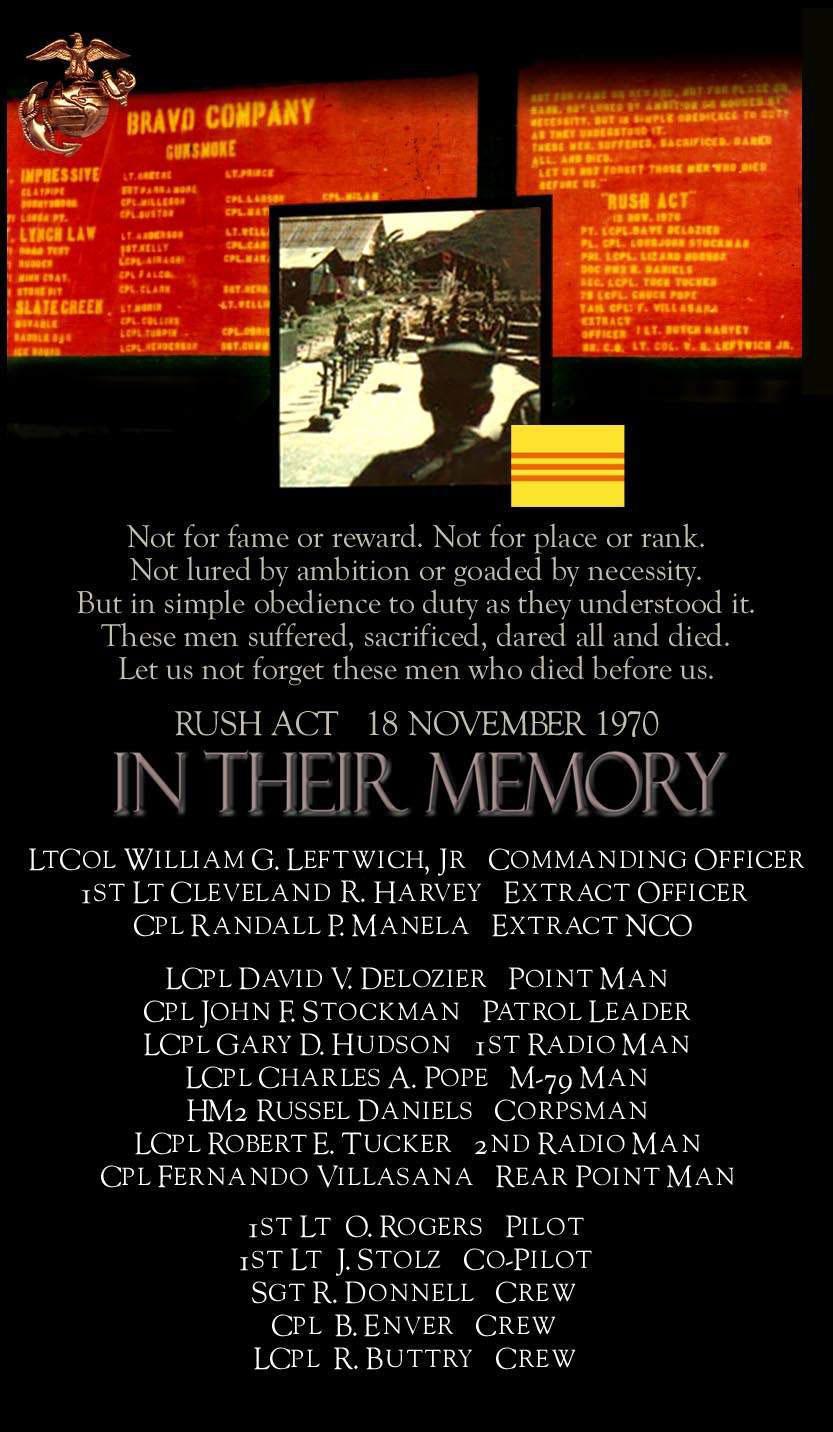 |
| Rush Act Tribute |
|
|
|
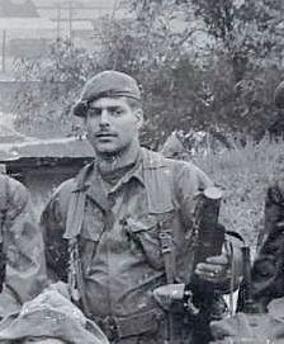 |
| Frank Bosco, Delta Company KIA June 21, 1969 |
|
|
|
*BELCHER, TED
Rank and organization: Sergeant, U.S. Army, Company C, 1st Battalion, 14th Infantry, 25th Infantry Division. Place and date: Plei Djerang, Republic of Vietnam, 19 November 1966. Entered service at: Huntington, W . Va. Born: 21 July 1924, Accoville, W . Va. Citation: Distinguishing himself by conspicuous gallantry and intrepidity at the risk of his life. Sgt. Belcher's unit was engaged in a search and destroy mission with Company B, 1st Battalion, 14th Infantry, the Battalion Reconnaissance Platoon and a special forces company of civilian irregular defense group personnel. As a squad leader of the 2d Platoon of Company C, Sgt. Belcher was leading his men when they encountered a bunker complex. The reconnaissance platoon, located a few hundred meters northwest of Company C, received a heavy volume of fire from well camouflaged snipers. As the 2d Platoon moved forward to assist the unit under attack, Sgt. Belcher and his squad, advancing only a short distance through the dense jungle terrain, met heavy and accurate automatic weapons and sniper fire. Sgt. Belcher and his squad were momentarily stopped by the deadly volume of enemy fire. He quickly gave the order to return fire and resume the advance toward the enemy. As he moved up with his men, a hand grenade landed in the midst of the sergeant's squad. Instantly realizing the immediate danger to his men, Sgt. Belcher, unhesitatingly and with complete disregard for his safety, lunged forward, covering the grenade with his body. Absorbing the grenade blast at the cost of his life, he saved his comrades from becoming casualties. Sgt. Belcher's profound concern for his fellow soldiers, at the risk of his life above and beyond the call of duty are in keeping with the highest traditions of the U.S. Army and reflect credit upon himself and the Armed Forces of his country
|
|
![]()
|
* FERNANDEZ, DANIEL
Rank and organization: Specialist Fourth Class, U.S. Army, Company C, 1st Battalion, 5th Infantry (Mechanized) 25th Infantry Division. Place and date: Cu Chi, Hau Nghia Province, Republic of Vietnam, 18 February 1966. Entered service at: Albuquerque, N. Mex. Born: 30 June 1944, Albuquerque, N. Mex. c.o. No.: 21, 26 April 1967. Citation: For conspicuous gallantry and intrepidity at the risk of his life above and beyond the call of duty. Sp4c. Fernandez demonstrated indomitable courage when the patrol was ambushed by a Viet Cong rifle company and driven back by the intense enemy automatic weapons fire before it could evacuate an American soldier who had been wounded in the Viet Cong attack. Sp4c. Fernandez, a sergeant and 2 other volunteers immediately fought their way through devastating fire and exploding grenades to reach the fallen soldier. Upon reaching their fallen comrade the sergeant was struck in the knee by machine gun fire and immobilized. Sp4c. Fernandez took charge, rallied the left flank of his patrol and began to assist in the recovery of the wounded sergeant. While first aid was being administered to the wounded man, a sudden increase in the accuracy and intensity of enemy fire forced the volunteer group to take cover. As they did, an enemy grenade landed in the midst of the group, although some men did not see it. Realizing there was no time for the wounded sergeant or the other men to protect themselves from the grenade blast, Sp4c. Fernandez vaulted over the wounded sergeant and threw himself on the grenade as it exploded, saving the lives of his 4 comrades at the sacrifice of his life. Sp4c. Fernandez' profound concern for his fellow soldiers, at the risk of his life above and beyond the call of duty are in the highest traditions of the U.S. Army and reflect great credit upon himself and the Armed Forces of his country.

|
|
|
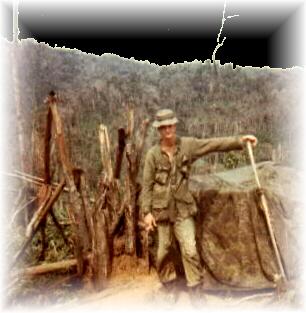 |
| L/Cpl James William Heagy |
|
|
|
|
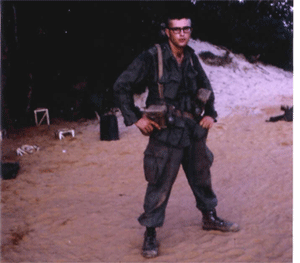 |
| Edward Rauch Alpha KIA Oct. 17, 1967 |
|
|
|
Name:Willard Edward Nelson
Home of Record: Walnut Creek, State: CA
D.O.B: Saturday, October 16, 1948
Military: Marine Corps
Rank: LCPL
MOC: 0311
Start of Tour: Thursday, August 17,1967
Date of Casualty: Tuesday,January 30,1968
Age At Time of Loss: 19
Casualty Type: (A1)Hostile,died
Reason:Small arms fire(ground casualty)
Country: South Vietnam
Province: Qaung Nam
The Wall Coordinates: Panel 35E- Row 077
| |
|
Captain
HHC, 1ST BN, 28TH INF RGT, 1 INF DIV
Army of the United States
01 March 1938 - 08 November 1966
Ponce, Puerto Rico
Panel 12E Line 044
|
The President of the United States
in the name of the Congress of the United States
takes pride in presenting the
MEDAL OF HONOR posthumously to
EURIPIDES RUBIO, JUNIOR
Captain
United States Army
for service as set forth in the following
CITATION:
For conspicuous gallantry and intrepidity in action at the risk of his life above and beyond the call of duty: On 8 November 1966, Captain Rubio, Infantry, was serving as Communications Officer, 1st Battalion, 28th Infantry in Tay Ninh Province, Republic of Vietnam, when a numerically superior enemy force launched a massive attack against the battalion defense position. Intense enemy machine gun fire raked the area while mortar rounds and rifle grenades exploded within the perimeter. Leaving the relative safety of his post, Captain Rubio received two serious wounds as he braved the withering fire to go to the area of most intense action where he distributed ammunition, re-established positions and rendered aid to the wounded. Disregarding the painful wounds, he unhesitatingly assumed command when a rifle company commander was medically evacuated. Captain Rubio was wounded a third time as he selflessly exposed himself to the devastating enemy fire to move among his men to encourage them to fight with renewed effort. While aiding the evacuation of wounded personnel, he noted that a smoke grenade which was intended to mark the Viet Cong position for air strikes had fallen dangerously close to the friendly lines. Captain Rubio ran to reposition the grenade but was immediately struck to his knees by enemy fire. Despite his several wounds, Captain Rubio scooped up the grenade, ran through the deadly hail of fire to within 20 meters of the enemy position and hurled the already smoking grenade into the midst of the enemy before he fell for the final time. Using the repositioned grenade as a marker, friendly air strikes were directed to destroy the hostile positions. Captain Rubio's singularly heroic act turned the tide of battle, and his extraordinary leadership and valor were a magnificent inspiration to his men. His remarkable bravery and selfless concern for his men are in keeping with the highest traditions of the military service and reflect great credit on Captain Rubio and the United States Army.
|
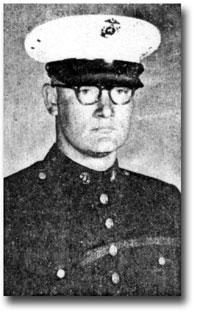 |
| Carey Lee Dobson |
|
|
 |
| Floyd Tyrone Flowers |
|
|
 |
| Eldin G. Berger |
|
|
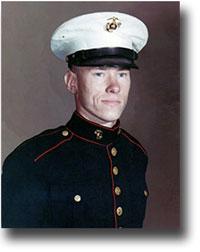 |
| Blaine Anthony DeBoard Jr |
|
|
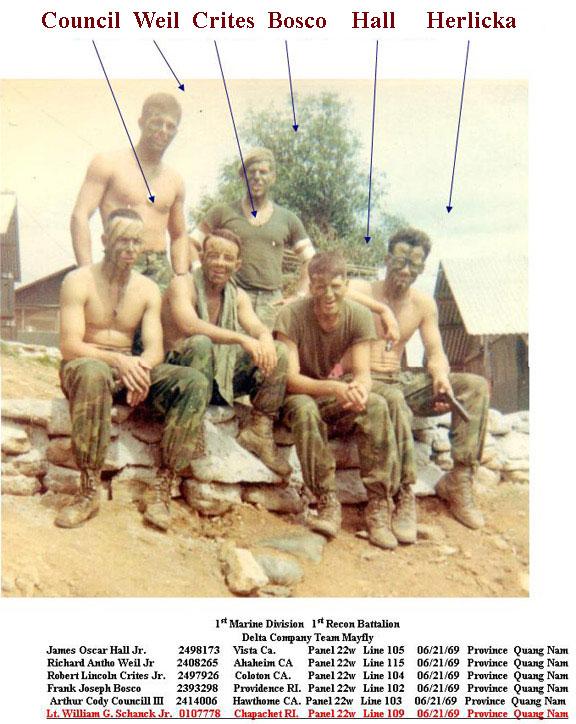 |
| Grade Level Tribute |
|
|
|
*GRANT, JOSEPH XAVIER
Rank and organization: Captain (then 1st Lt.), U.S. Army, Company A, 1st Battalion, 14th Infantry, 25th Infantry Division. Place and date: Republic of Vietnam, 13 November 1966. Entered service at: Boston, Mass. Born: 28 March 1940, Cambridge, Mass. G.O. No.: 4, 29 January 1968. Citation: For conspicuous gallantry and intrepidity in action at the risk of his life above and beyond the call of duty. Company A was participating in a search and destroy operation when the leading platoon made contact with the enemy and a fierce fire-fight ensued.
| Name: James Henry NcLean
Rank/Branch: E4/US Army
Unit: Medic Team 88, MAC-V
D.O.B: 16 June 1944
Home City of Record: Los Angeles,CA
Date of Loss: 09 Febuary 1965
Country of Loss: South Vietnam
Loss Coordinates: 114847N 1071522E
Status(in 1973): Prisoner of War
Category: 1
Aircraft/Vehicle/Ground: Ground
Other Personnel in Incident: (None Missing)
|
Capt. Grant was ordered to disengage the 2 remaining platoons and to maneuver them to envelop and destroy the enemy. After beginning their movement, the platoons encountered intense enemy automatic weapons and mortar fire from the front and flank. Capt. Grant was ordered to deploy the platoons in a defensive position. As this action was underway, the enemy attacked, using "human wave'' assaults, in an attempt to literally overwhelm Capt.
| |
| Grant's force. In a magnificent display of courage and leadership, Capt. Grant moved under intense fire along the hastily formed defensive line repositioning soldiers to fill gaps created by the mounting casualties and inspiring and directing the efforts of his men to successfully repel the determined enemy onslaught. Seeing a platoon leader wounded, Capt. Grant hastened to his aid, in the face of the mass of fire of the entire enemy force, and moved him to a more secure position. During this action, Capt. Grant was wounded in the shoulder. Refusing medical treatment, he returned to the forward part of the perimeter, where he continued to lead and to inspire his men by his own indomitable example. While attempting to evacuate a wounded soldier, he was pinned down by fire from an enemy machine gun. With a supply of hand grenades, he crawled forward under a withering hail of fire and knocked out the machine gun, killing the crew, after which he moved the wounded man to safety. Learning that several other wounded men were pinned down by enemy fire forward of his position, Capt. Grant disregarded his painful wound and led 5 men across the fire-swept open ground to effect a rescue. Following return of the wounded men to the perimeter, a concentration of mortar fire landed in their midst and Capt. Grant was killed instantly. His heroic actions saved the lives of a number of his comrades and enabled the task force to repulse the vicious assaults and defeat the enemy. Capt. Grant's actions reflect great credit upon himself and were in keeping with the finest traditions of the U.S. Army.

|
SP4 James H. McLean was a medic assigned to Advisory Team 88,MAC-V, serving with a South Vietnamese Regional forces unit at Duc Phong, Phuoc Long Province, Republic of Vietnam. On Febuary 9, 1965, at about midnight, Duc Phong came under attack and was seized by the Viet Cong.The Following day, an ARVN unit was inserted into the area, and learned that an American had been observed being held captive in the vicinity of Duc Phong. Enemy fire drove observing helicopters away. By mid-aternoon on Febuary 10, the ARVN unit that had been inserted had recaptured the camp and recovered the remains of 3 American Advisors. As none of them was McLean, it was determined that the captured American was McLean. Several released and escaped South Vietnamese captured in the same incident or held in Various camps with McLean later reported that SP4 McLean had been captured uninjured. He was last seen alive in late 1966, having been detained all this time in camps in Northern Phuoc Long Province. Although one of the released POW's stated that he had seen McLean sick and never saw him again, McLean's name never appeared on lists provided which named those who died in captivity. He was not released in 1973 in the general prisoner release.
|
In February and March, 1973, following the Paris Peace Accords, 591 Americans (26 of them civilians) were released by the Communist authorities. All had been held as prisoners of war, principally in North Vietnam, and the vast majority were USAF or USN airmen shot down during operations Rolling Thunder (1965-68) and Linebacker (1972). Some had been held in confinement under inhumane conditions for up to eight years; one of them, USN Lieutenant Everett Alvarez, had been shot down during a Pierce Arrow retaliatory strike on Hon Gai in August, 1964. Any U.S. airman who ejected over the North faced immediate problems. In many cases, the process of ejection led to physical injury. This, coupled with the trauma of suddenly being shot out of the sky and the fact that, as a pale-skinned American, he could not hide among the local people, made evasion extremely difficult. Although air rescue was possible and did occur, most airmen were quickly picked up by the Communist authorities--in many instances not before being beaten by irate civilians.
The usual procedure was for the captive airman to be paraded before the people (and the propaganda cameras) as a "capitalist hired gun" or "imperialist air pirate" before being transferred to the old French colonial prison of Hoa Lo in the center of Hanoi. Here he would be stripped, searched, and--usually after a period of solitary confinement to increase disorientation--interrogated in "New Guy Village," part of the Hoa Lo compound reserved for new arrivals. At this stage, he would be aware that he was in the "Hanoi Hilton" and that escape was impossible. He would be allowed no contact with fellow prisoners.
|
This isolation would continue in other compounds--nicknamed "Las Vegas" and "Heartbreak Hotel"--where he would be subjected to more questioning and, more often than not, brutal torture. The latter was in violation of the Geneva Conventions governing the treatment of PoWs, but the Communists' view was that because war had not been officially declared, the Americans were acting illegally and so deserved no protection,
There was even talk of war-crimes trials of U.S. airmen being held, although this idea was dropped after intense diplomatic pressure on Hanoi. Under torture--which included tying the prisoners so tightly that joints were dislocated and breathing was restricted-- many Americans wrote "confessions," couched in such ridiculous language that no one took them seriously outside the Communist bloc. One PoW, brought before the press in Hanoi, even winked the word "torture" in Morse code to alert the U.S. Government.
Such bravery was indicative of the resolve of the majority of the PoWs, who maintained their dignity and discipline throughout their ordeal. Contact between them was established by means of a simple code, transmited by tapping pipes, winking, or coughing, and, after the unsuccessful U.S. Son Tay raid in November, !970, most of the men were brought together in the Hanoi Hilton from outlying compounds such as the "Briarpatch" (35 miles northwest of Hanoi) and the "Zoo" (in Cu Loc}. A more communal life was then possible, The prisoners were eventually returned by the Hanoi government to the United States in early 1973--an event that was highly emotional for both the men and their longsuffering friends and families.
|
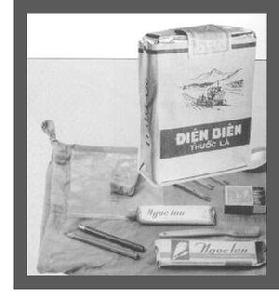 |
| The personal effects brought home from North Vietnam by an American POW include locally produced cigarettes, matches, and toothpaste. |
|
|
 |
| Lieutenant Colonel James Lindbeg Hughes, shot down over the North in 1967, is marched into custody in Hanoi by his captors. |
|
|
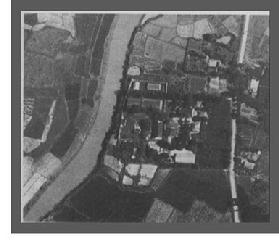 |
| The layout of the Son Tay prison camp is shown in this aerial view. The U.S. raid on the camp on November 21, 1970, to liberate American PoWs was well exectued but fruitless: the PoWs had previously been moved to another location. |
|
|
|
|
 |
| Lieutenant Colonel Robert L. Strim is welcomed home by his family in March, 1971. An enormous outpouring of public emotion accompanied the return of the POWs to the U.S |
|
|
|
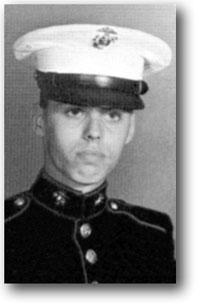 |
| Ernest E. Orendorff Jr |
|
| |
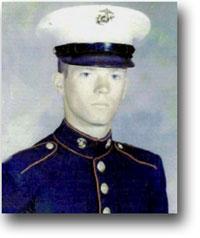 |
| Michael Franklin Sheridan |
|
|
|
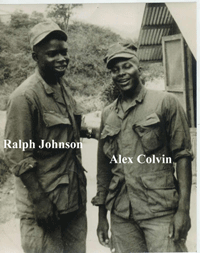 |
| Photos courtesy of Alex Colvin |
|
|
The President of the United States takes pride in presenting the MEDAL OF HONOR posthumously to
PRIVATE FIRST CLASS RALPH H. JOHNSON
UNITED STATES MARINE CORPS
for service as set forth in the following
CITATION:
For conspicuous gallantry and intrepidity at the risk of his life above and beyond the call of duty while serving as a reconnaissance scout with Company A, First Reconnaissance Battalion, First Marine Division in action against the North Vietnamese Army and Viet Cong forces in the Republic of Vietnam. In the early morning hours of 5 March 1968, during OPERATION ROCK, First Class Johnson was a member of a fifteen-man reconnaissance patrol manning an observation post on Hill 146 overlooking the Quan Duc Duc Valley deep in enemy controlled territory. They were attacked by a platoon-size hostile force employing automatic weapons, satchel charges and hand grenades. Suddenly a hand grenade landed in the three- man fighting hole occupied by Private First Class Johnson and two fellow Marines. Realizing the inherent danger to his comrades, he shouted a warning and unhesitatingly hurled himself upon the explosive device. When the grenade exploded, Private First Class Johnson absorbed the tremendous impact of the blast and was killed instantly. His prompt and heroic act saved the life of one Marine at the cost of his own and undoubtedly prevented the enemy from penetrating his sector of the patrol's perimeter. Private First Class Johnson's courage inspiring valor and selfless devotion to duty were in keeping with the highest traditions of the Marine Corps and the United States Naval Service. He gallantly gave his life for his country.
|
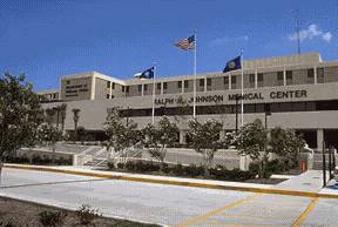 |
| On September 5th, 1991, the Charleston Veterans Affairs Medical Center was dedicated to Ralph H Johnson. |
|
|
|
|
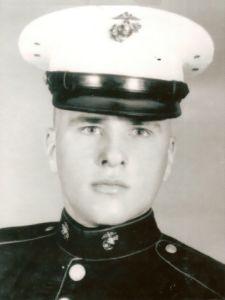 |
| Jerrald Rich Thompson |
|
|
|
The President of the United States takes pride in presenting the NAVY CROSS posthumously to
CORPORAL JERRALD R. THOMPSON
UNITED STATES MARINE CORPS for service as set forth in the following
CITATION:
For extraordinary heroism as a squad leader serving with the First Platoon, Company C, First Reconnaissance Battalion, First Marine Division (Reinforced) in the Republic of Vietnam on 16 June 1966. While occupying an observation post at 0100 on Hill 488, Quang Tin Province, deep in enemy controlled territory, the platoon of 18 men was subjected to an intense assault by a North Vietnamese unit estimated at battalion size. Corporal Thompson immediately ordered his squad to withdraw to a predetermined defensive perimeter. Braving a hail of small arms fire, automatic weapons, and mortar fire, the small band of courageous Marines fought their way to the relative safety of the defensive position. In the course of this action, Corporal Thompson was painfully wounded by an enemy hand grenade and was unable to proceed. Armed only with a knife, he engaged the enemy in hand-to-hand combat and killed two before he fell, mortally wounded. By his indomitable spirit in the face of seemingly insurmountable odds he was instrumental in the defense of his platoon's position. Corporal Thompson's courageous action under hostile fire reflected great credit upon himself and the Marine Corps and upheld the highest traditions of the United States Naval Service. He gallantly gave his life in the cause of freedom.
|
Important Message
This Website Terms and Condition of Use Agreement
also known as a 'terms of service agreement'
Will be at the bottom of most web pages!
Please read it before using this website.
Thank You
|
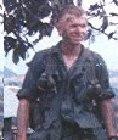 |
| Ronald Frederick Kitzke KIA 27 Dec. 67 32-E-76 |
|
|
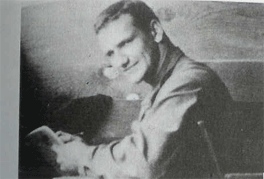 |
| Tom Jennings Alpha KIA March 3, 1968 |
|
|
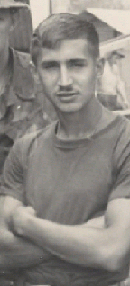 |
| John V. Kuchta Delta Co. KIA 2/6/69 |
|
| |
This website contains, in various sections, portions of copyrighted material not specifically authorized by the copyright owner. This material is used for educational purposes only and presented to provide understanding or give information for issues concerning the public as a whole. In accordance with U.S. Copyright Law Title 17 U.S.C. Section 107, the material on this site is distributed without profit. More Information
Information presented based on medical, news, government, and/or other web based articles or documents does not represent any medical recommendation or legal advice from myself or West Saint Paul Antiques. For specific information and advice on any condition or issue, you must consult a professional health care provider or legal advisor for direction.
I and West Saint Paul Antiques can not be responsible for information others may post on an external website linked here ~ or for websites which link to West Saint Paul Antiques. I would ask, however, that should you see something which you question or which seems incorrect or inappropriate, that you notify me immediately at floyd@weststpaulantiques.com Also, I would very much appreciate being notified if you find links which do not work or other problems with the website itself. Thank You!
Please know that there is no copyright infringement intended with any part of this website ~ should you find something that belongs to you and proper credit has not been given (or if you simply wish for me to remove it),
just let me know and I will do so right away.
|
Website Terms and Condition of Use Agreement
also known as a 'terms of service agreement'
By using this website, West Saint Paul Antiques . Com, you are agreeing to use the site according to and in agreement with the above and following terms of use without limitation or qualification. If you do not agree, then you must refain from using the site.
The 'Terms of Use' govern your access to and use of this website and facebook pages associated with it. If you do not agree to all of the Terms of Use, do not access or use the website, or the facebook sites. By accessing or using any of them, you and any entity you are authorized to represent signify your agreement to be bound by the Terms of Use.
Said Terms of Use may be revised and/or updated at any time by posting of the changes on this page of the website. Your continued usage of the website, or the facebook site(s) after any changes to the Terms of Use will mean that you have accepted the changes. Also, any these sites themselves may be changed, supplemented, deleted, and/or updated at my sole discretion without notice; this establishes intellectual property rights by owner (myself).
It saddens me to include a Terms of Use for West Saint Paul Antiques . Com, but we all realize it is something that is necessary and must be done these days. By using the website, or facebook for West Saint Paul Antiques, you represent that you are of legal age and that you agree to be bound by the Terms of Use and any subsequent modifications. Your use of the West Saint Paul Antiques sites signify your electronic acceptance of the Terms of Use and constitute your signature to same as if you had actually signed an agreement embodying the terms.
|
|